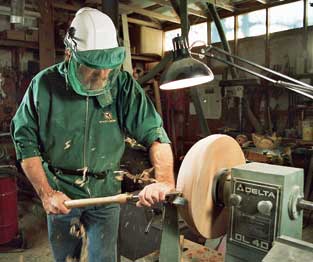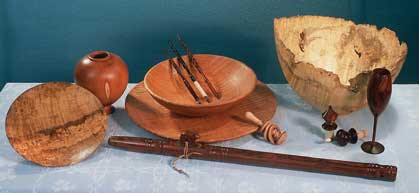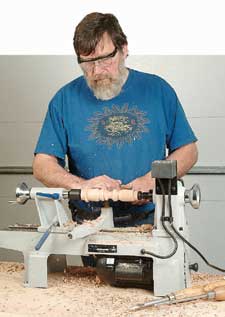
Woodturners are a unique breed of woodworker. They usually have a background in more general woodworking and can still take on the related tasks when needed. But somewhere along the way, the idea of transforming a spinning chunk of wood into a bowl, vase, or bedposts took hold and never let go.
Steve Blenk, familiar to Woodworker’s Journal magazine readers and the countless people he’s trained, is a perfect example of that. Woodworking was in his blood from an early age. His grandfather was a serious woodworker. An immigrant from Poland, he lived with Steve’s family when Steve was a child.
“He spoke wood better than he spoke English,” Steve laughed. “He was a very careful kind of guy and taught me a few good lessons along the way. Mostly he would look over my shoulder and when I did something wrong, he made a disgusted kind of noise and would grab the chisel and say WATCH!”
That was back in New York, where Steve initially pursued a career in teaching. And when he moved to the West Coast, he worked in the construction trade. But his interest in woodworking prevailed and, 23 years ago, he opened a woodworking business.
“And for some reason or another, I gravitated towards the lathe right away. I liked what I call the ‘Instant Gee-Whiz Factor,’ which is the instant gratification and satisfaction you get on the lathe. And when you really learn to use the chisel, it’s like they become an extension of your fingers.”
Steve is pretty much self-taught on the lathe. Through trial and error, he learned there’s no single right way to work on the lathe, but there were plenty of wrong ways. Fortunately, he found other woodturners who were glad to share their techniques.
“Woodturners by and large are a lot more open about their techniques and tricks than a lot of the other people in the woodworking business. The lathe is a hands-on tool. I could tell you something nine times, but it doesn’t make any sense until you have the tool in your hand. Put 10 good turners in a room and tell them to make something. They all make it, but they make it 10 different ways. They won’t use the same chisels, and they won’t set things up exactly the same way.”
He feels woodturning has come a long way since the 1950s and 1960s.

“In shop classes at high school they would grab 40 pieces of awful end-grain oak and walnut, glue it together in a block. Running at three to six thousand RPMs, they’d go into it with a round-nose scraper, get beat to death by vibrations, and eventually get a depression in the middle of it that they called a bowl. What we had lost was the European concept of shearing, rather than scraping. In the old days turners could walk into the woods in the fall with a jackknife, make themselves a spring pole lathe where they just had a turn and a half each time, so there is no way they could scrape. Yet they’d come out with components to make a bunch of Windsor chairs.”
For Steve the first step is reading the grain on a piece before mounting it.
“You give yourself some options, so when I start to set up a bowl blank instead of screwing it right to a face plate, I might first set it up between centers and move that center point two or three times to show some nice spalting or a bit of fiddleback before I get it roughed out,” Steve explained.
“If you think of the way a block plane cuts,” he continued, “the sole of the block plane is actually controlling the amount of iron you have sticking out, and as long as it doesn’t exceed what can be taken off cleanly in one pass, you will be able to get a smooth cut. A gouge performs the same function. When you’re just taking stuff off, you grab a big old gouge – it’s called a roughing gouge, but I call it a hand grenade — and you go in and blow the stuff out. But when you get to the fine cuts, you’re bringing that cutting edge in tangent to the turning and taking a very fine shaving &the finer the shaving, the cleaner the surface you leave behind. If I move this chisel down about a five-degree angle, all of a sudden the shaving whispers off instead of it feeling like a jackhammer. Ideally, when you make a cut on the lathe you should be leaving behind a surface that at worst should maybe be addressed with something like 180 or 220 grit.
“You work in two dimensions when you’ re wood turning & the shape and the surface. Shape is easy, you can hold a tire-iron up to the piece and it will hack off wood and change the shape. Surface is a completely different dimension. The idea is to leave a surface behind that someone is actually going to want to look at when the lathe is stopped. This is where technique and expertise really come in.”
Steve started the writing side of his business working for American Woodworker. The editors saw him demonstrating Delta lathes at the IWF in Atlanta and suggested he try writing. His degree was in English, so he started by writing a few articles for them.

“I enjoy writing about turning as much as I enjoy teaching. In some ways putting it in a magazine is the best of both worlds. You can teach someone without holding his or her hand.”
For the past four years, he’s also been building a house and feels he’s been somewhat absent from the woodturning scene. Now that the house is complete, he wants to get back out there to see what other folks have been up to.
“I have made everything from half-inch tall goblets to Victorian porch columns. Though there is probably not much new we can do with wood anymore, there’s no end to how we can do it. There is a level of creativity to turning that is kind of absent from any other woodworking tool.”
Asked if he considers himself a master turner, his response is characteristically humble: “Talk to me in another 20 years.”






